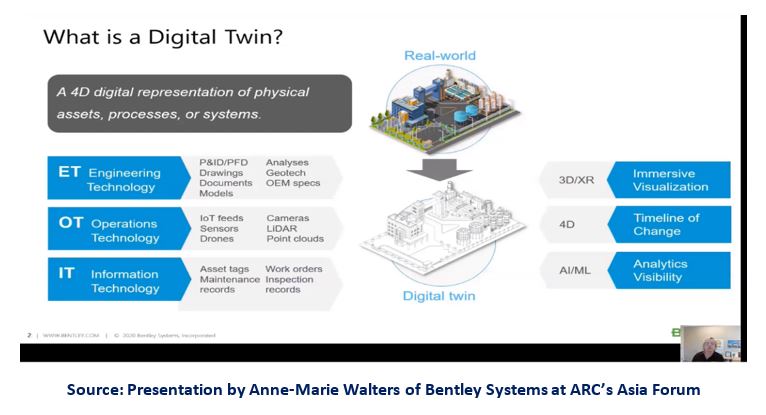

Bentley Systems participated as a Gold Sponsor at the online ARC Industry Forum Asia titled Accelerating Digital Transformation in a Post-COVID World, held from July 13-15, 2021.
Anne-Marie Walters, Industry Marketing Director, Bentley Systems, spoke about the need for the open digital twin to support industrywide collaboration across the entire ecosystem from contract business suppliers to owners and operators. Companies and industry leaders across the globe are realizing the benefits of digital twins. This blog post captures the highlights of Ms. Walters’ presentation. Her presentation video (Day 1, Session 2) will be available at the vFairs platform for the next three months. The documents and video link are also available at Bentley’s virtual booth.
A digital twin is a visual representation of a physical asset and how the asset is changing or has changed over time. The digital twin is informed by information technology (IT), operational technology (OT), and engineering technology (ET) systems. To deliver value, a digital twin should have analytics capabilities to focus attention on what really matters, sort through the masses of data, and support decision-making in real time.

The common challenges that oil and gas operators face include aging assets, managing ecosystems, achieving safety targets, complying with regulations, and optimizing asset performance. The oil and gas sector is also working to lower emissions and combat climate change through radical change across their organizations. They need everyone in their ecosystem to collaborate and accelerate the radical changes needed, and to accomplish this, the sector needs interoperability, scalability, and integrated data across company boundaries. Open digital twins drive transparency and automation, helping to overcome these challenges. In the United Kingdom, government has mandated the deployment of digital twins in all infrastructure built with and maintained by government funds to streamline collaboration and reduce infrastructure maintenance. The ecosystem of connected digital twins centers around openness, which is fundamental for collaboration and successful digital transformation.
Bentley’s software helps organizations to design, build, and operate infrastructure assets. They offer many engineering applications across industries, such as roads, buildings, plants, and for manufacturing, throughout each asset’s lifecycle. While Bentley provides digital twin solutions for many industries, such as PlantSight for process industries and OpenGrid for electric utilities, they cannot provide solutions across the board. Hence, Bentley recognizes the need for an open ecosystem of developers that can use a digital twin approach to create their own solutions to fill the gaps. Bentley’s expertise in engineering solutions across disciplines and tracking changes across these complex engineering tools has led to a cloud-based federated data approach to provide a common digital twin framework known as iTwin, an open, scalable, cloud platform-as-a-service that runs on Microsoft Azure.
The telecom industry is leading the way in infrastructure change and is demonstrating the widespread future use of digital twins for all asset types. Telecom organizations are demanding digital twins across their fleets of assets for safety, compliance, quality, and competitive edge. Participants in this competitive sector constantly need to increase capacity and keep up with new technology. Now, the advanced 5G technology standard is being added to existing networks. Bentley is working with partners to produce digital twin solutions that automate the capture of the telecom industry’s existing assets, support new digital workflows, and embed industry standards. Using drones and reality modeling, Bentley’s solutions can zero in on the trouble spots, identify obsolete equipment, and generate accurate asset records from ongoing operations and maintenance. In this context, Ms. Walters spoke about Bentley’s OpenTower iQ, a digital joint venture with telecom operators for 5G towers. This comprehensive solution is being stress-tested in live adoption for infrastructure digital twins of the world’s communication towers.
Below are highlights of three case studies that substantiate the benefits of deploying digital twins:
BP Oman uses Bentley’s technologies for their capital projects to enable collaboration between their contractors and manage handovers. Establishing a centralized information store improved document coordination by 25 percent, lowered information search time by 30 percent, dropped data exchange time by 70 percent, and helped start production ahead of schedule and under budget.
Shell Deepwater was driven by an increasing demand to reduce capital costs and seek new approaches to offshore production. They needed a way to improve their contextual and detailed planning, streamline their capital projects, and provide an ecosystem to collaborate with their contractors and equipment suppliers. After careful evaluation, they deployed the Bentley iTwin Platform. Through their partnership with FutureOn, Bentley is helping to accelerate the delivery of subsea digital twins for oil and gas production and in the new field of offshore wind.
AAEngineering developed a new gold processing plant in Kazakhstan. Drilling and geological studies revealed a new gold ore and major investments were required to extract it. The project owner needed to construct significant new assets, including a processing plant, water pipelines, and an electric substation. Bentley’s digital twin solutions were deployed from concept to start-up. The digital twin reduced engineering time by 30 percent, while the use of drones to update the development model reduced travel to site by 75 percent during the pandemic, putting the project ahead of schedule.

